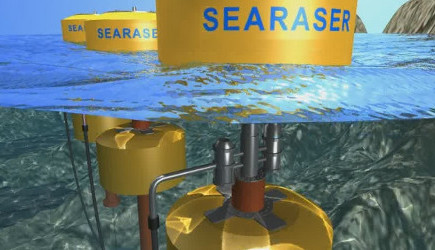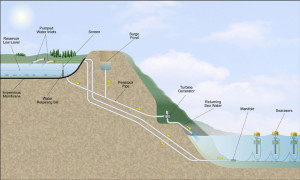'Seamill' harnasses Ocean Swell to Generate Electricity on Land
October 30, 2014
on
on

The 'seamill' named Searaser uses wave power to generate electricity on land. Contrary to intermittent sources like solar and wind, the Searaser's energy production can be controlled.
Inventor Alvin Smith patented the Searaser in 2007. In 2012 he teamed up with British company Ecotricity to bring the technology to the market. For the last 18 months the Ecotricity team has been working on optimizing the original design and now they're testing a prototype in a lab.
Smith said about the trials: “We’ve just completed wave tank testing at Plymouth University to validate the extensive computer modeling we’ve been undertaking. We’ve put Searaser through the most extreme testing regime at Plymouth’s CoastLAB and it’s passed every challenge.”
Hydropower
The seamill pumps water into a basin or storage tank on higher ground where it is used to drive hydropower turbines. The Searaser consists of a piston fastened between two floats. One float is suspended underwater tethered to the seabed with a weight, the other rises and falls on the ocean swell. With each passing wave the double acting piston pumps water onto the shore. When the elevated water is released back into the ocean, it activates turbines to produce electricity.
Click to enlarge. Source: searaser.net

Low cost
The land based energy production of the Searaser is an advantage over other forms of wave energy capture. The electrical parts of the system aren't exposed to the harsh conditions of the ocean environment, saving costs on offshore engineering.
Controllable energy production
Controllable supply is another advantage. Electricity can be generated on demand because hydropower is a storable energy source. The Searaser can also generate electricity if higher ground is not available. The pumped water, with the aid of an accumulator, will be pressurized sufficiently to drive a turbine. However, without storage the controllability of energy production will be lost.
Roadmap
Ecotricity aims to test the first prototypes at sea in about 12 months and deploy the Searaser as a viable energy source in a few years.
Image: Source: Ecotricity.
Inventor Alvin Smith patented the Searaser in 2007. In 2012 he teamed up with British company Ecotricity to bring the technology to the market. For the last 18 months the Ecotricity team has been working on optimizing the original design and now they're testing a prototype in a lab.
Smith said about the trials: “We’ve just completed wave tank testing at Plymouth University to validate the extensive computer modeling we’ve been undertaking. We’ve put Searaser through the most extreme testing regime at Plymouth’s CoastLAB and it’s passed every challenge.”
Hydropower
The seamill pumps water into a basin or storage tank on higher ground where it is used to drive hydropower turbines. The Searaser consists of a piston fastened between two floats. One float is suspended underwater tethered to the seabed with a weight, the other rises and falls on the ocean swell. With each passing wave the double acting piston pumps water onto the shore. When the elevated water is released back into the ocean, it activates turbines to produce electricity.
Click to enlarge. Source: searaser.net

Low cost
The land based energy production of the Searaser is an advantage over other forms of wave energy capture. The electrical parts of the system aren't exposed to the harsh conditions of the ocean environment, saving costs on offshore engineering.
Controllable energy production
Controllable supply is another advantage. Electricity can be generated on demand because hydropower is a storable energy source. The Searaser can also generate electricity if higher ground is not available. The pumped water, with the aid of an accumulator, will be pressurized sufficiently to drive a turbine. However, without storage the controllability of energy production will be lost.
Roadmap
Ecotricity aims to test the first prototypes at sea in about 12 months and deploy the Searaser as a viable energy source in a few years.
Image: Source: Ecotricity.
Read full article
Hide full article


Discussion (0 comments)